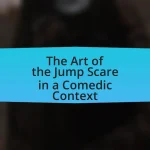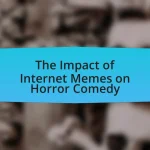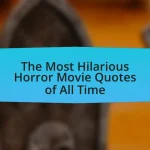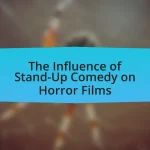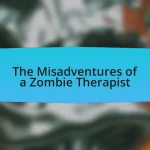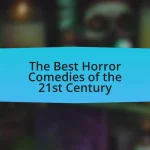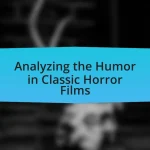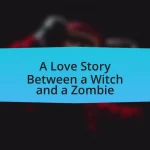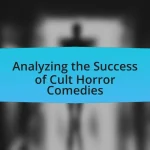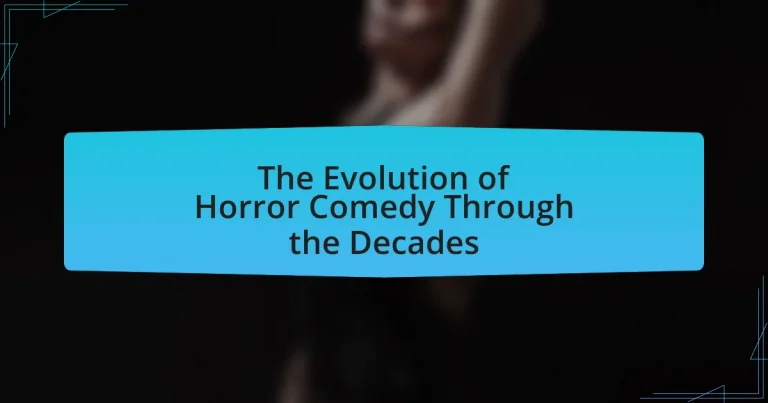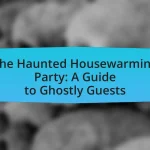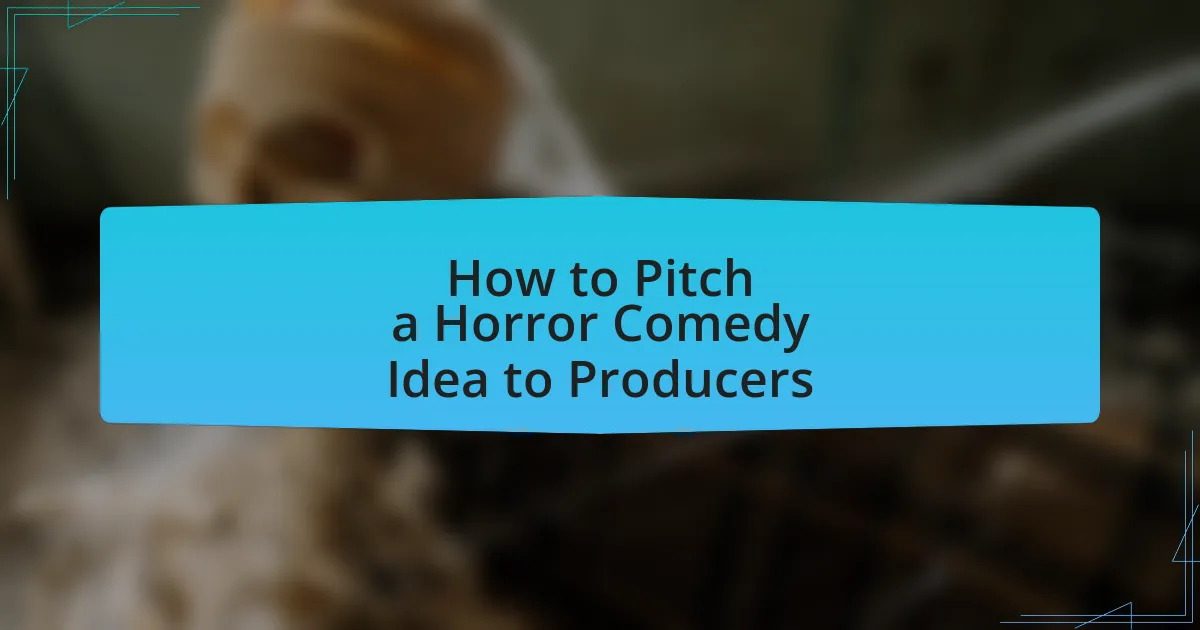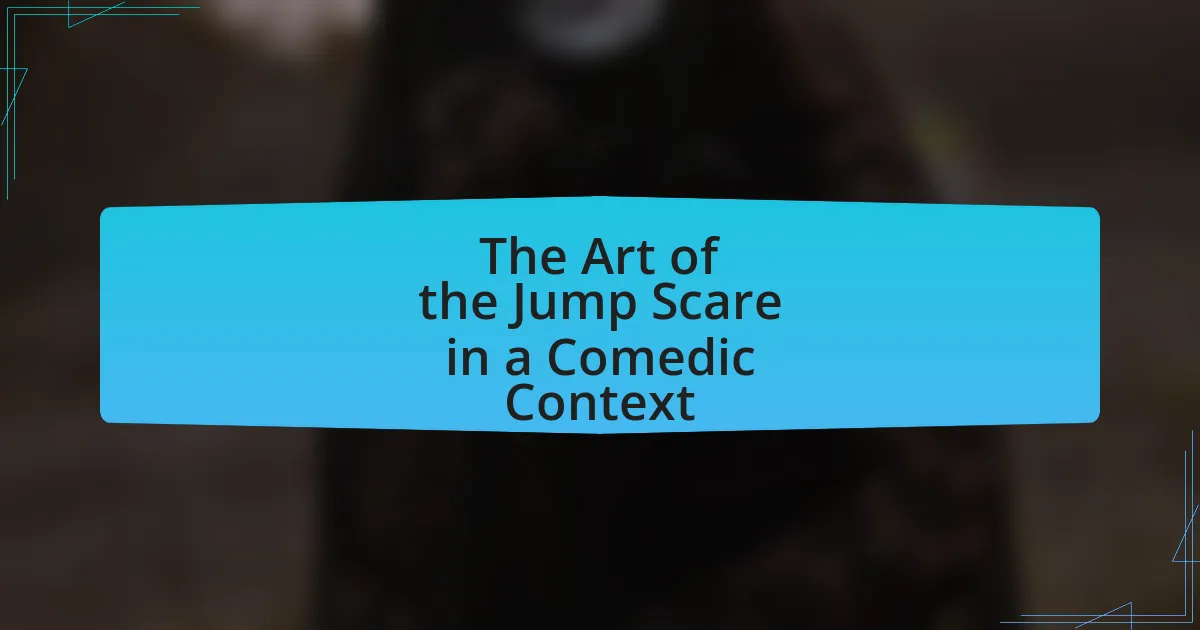The article examines the evolution of horror comedy, tracing its development from the early 20th century to contemporary cinema. It highlights key milestones, such as “Abbott and Costello Meet Frankenstein” and “Shaun of the Dead,” illustrating how the genre has blended horror elements with comedic themes over the decades. The discussion includes the defining characteristics of horror comedy in various eras, the impact of cultural influences, and the significance of the genre in providing societal commentary. Additionally, it explores how horror comedy intersects with other genres and the best practices for writing effective horror comedy scripts.
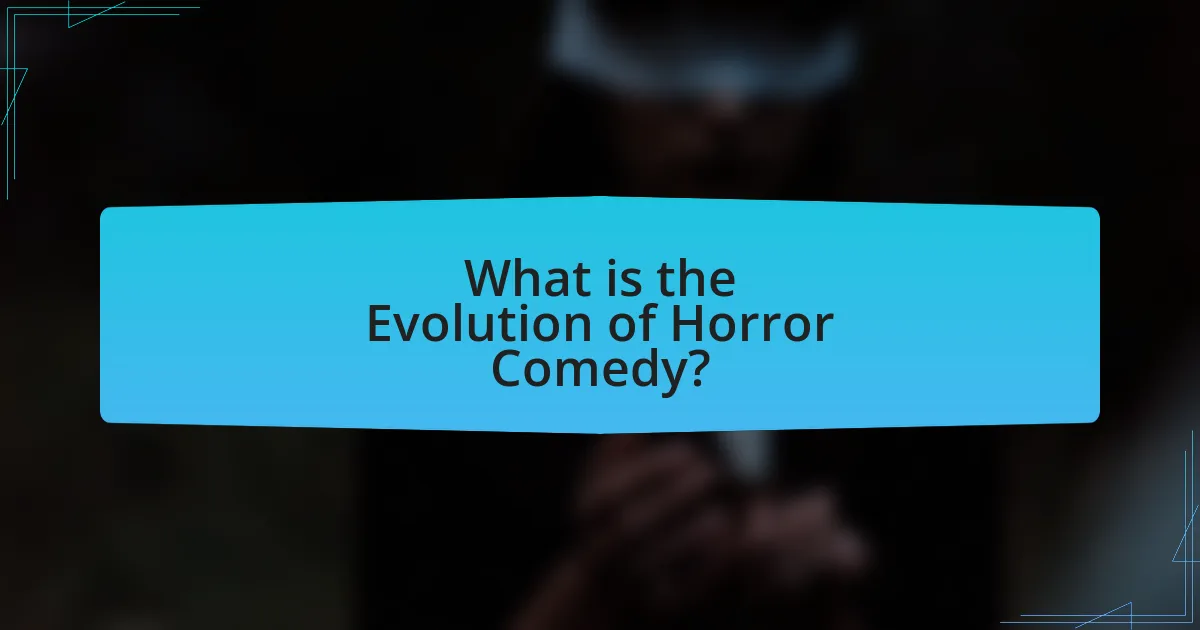
What is the Evolution of Horror Comedy?
The evolution of horror comedy is characterized by the blending of horror elements with comedic themes, which has developed significantly since the early 20th century. Initially, films like “The Cabinet of Dr. Caligari” (1920) established a foundation for horror, while the introduction of comedic elements began with works such as “Abbott and Costello Meet Frankenstein” (1948), which combined classic horror monsters with humor.
In the 1980s, films like “Ghostbusters” (1984) and “The Evil Dead II” (1987) further popularized the genre by mixing slapstick comedy with horror tropes, appealing to a broader audience. The 2000s saw a resurgence with movies like “Shaun of the Dead” (2004), which cleverly parodied zombie films while maintaining genuine horror elements.
This genre continues to evolve, as seen in recent productions like “What We Do in the Shadows” (2014), which showcases a mockumentary style that humorously explores vampire lore. The consistent integration of humor into horror narratives reflects cultural shifts and audience preferences, demonstrating the genre’s adaptability and enduring appeal.
How has horror comedy changed over the decades?
Horror comedy has evolved significantly over the decades, transitioning from the slapstick and campy styles of the early 20th century to more sophisticated and subversive narratives in contemporary cinema. In the 1930s and 1940s, films like “Abbott and Costello Meet Frankenstein” showcased a blend of humor and horror through lighthearted interactions with classic monsters, emphasizing physical comedy. The 1980s introduced a darker tone with films like “Evil Dead II,” which combined gore with absurdity, reflecting a shift towards self-aware humor. By the 2000s, movies such as “Shaun of the Dead” and “What We Do in the Shadows” further transformed the genre, incorporating social commentary and character-driven plots, indicating a maturation of horror comedy that resonates with modern audiences. This evolution illustrates how horror comedy has adapted to cultural shifts and audience expectations over time.
What are the defining characteristics of horror comedy in different eras?
Horror comedy is characterized by its blend of comedic elements with horror themes, which has evolved significantly across different eras. In the early 20th century, films like “The Cabinet of Dr. Caligari” introduced dark humor alongside psychological horror, setting a foundation for the genre. The 1930s and 1940s saw the emergence of classic horror comedies such as “Abbott and Costello Meet Frankenstein,” which combined slapstick humor with iconic horror figures, emphasizing absurdity and parody.
The 1980s marked a pivotal era with films like “Evil Dead II,” which integrated gore with humor, showcasing a self-aware style that appealed to both horror and comedy audiences. In the 2000s, movies like “Shaun of the Dead” further refined the genre by blending social commentary with comedic horror, reflecting contemporary societal issues while maintaining a humorous tone. Each era’s defining characteristics highlight the genre’s adaptability and its ability to reflect cultural shifts, making horror comedy a unique and evolving form of entertainment.
How do cultural influences shape horror comedy trends?
Cultural influences shape horror comedy trends by reflecting societal fears, humor styles, and historical contexts. For instance, during the 1980s, the rise of slasher films paralleled societal anxieties about crime and violence, leading to horror comedies like “The Return of the Living Dead,” which blended humor with horror elements to address these fears. Additionally, cultural shifts, such as the acceptance of diverse voices in media, have led to innovative horror comedies like “Get Out,” which uses satire to critique racial tensions. These examples illustrate how cultural contexts directly inform the themes, styles, and narratives within horror comedy, making the genre a mirror of societal values and concerns.
Why is horror comedy significant in film and television?
Horror comedy is significant in film and television because it effectively blends elements of fear and humor, allowing audiences to experience a unique emotional range. This genre serves as a cultural commentary, often reflecting societal fears while simultaneously providing relief through laughter. For instance, films like “Shaun of the Dead” and “What We Do in the Shadows” have successfully utilized this blend to critique social norms and explore themes of mortality, making horror comedy a versatile tool for storytelling. The ability to juxtapose horror and comedy can also enhance viewer engagement, as it creates a dynamic viewing experience that keeps audiences invested.
What role does horror comedy play in societal commentary?
Horror comedy serves as a critical lens for societal commentary by blending humor with horror elements to address and critique social issues. This genre allows creators to explore themes such as fear, morality, and societal norms in a way that is both entertaining and thought-provoking. For instance, films like “Get Out” utilize horror comedy to highlight racial tensions and systemic racism, effectively engaging audiences in discussions about these serious topics while providing comic relief. The juxtaposition of humor and horror can disarm viewers, making them more receptive to the underlying messages about societal flaws and human behavior.
How does horror comedy balance fear and humor?
Horror comedy balances fear and humor by juxtaposing terrifying elements with comedic relief, creating a unique emotional experience. This genre often employs techniques such as absurdity, irony, and exaggeration to subvert traditional horror tropes, allowing audiences to laugh at what would typically be frightening. For example, films like “Shaun of the Dead” blend zombie apocalypse scenarios with humorous character interactions, effectively diffusing tension while maintaining a sense of danger. This interplay between fear and humor can enhance viewer engagement, as laughter can serve as a coping mechanism for fear, making the horror elements more palatable.
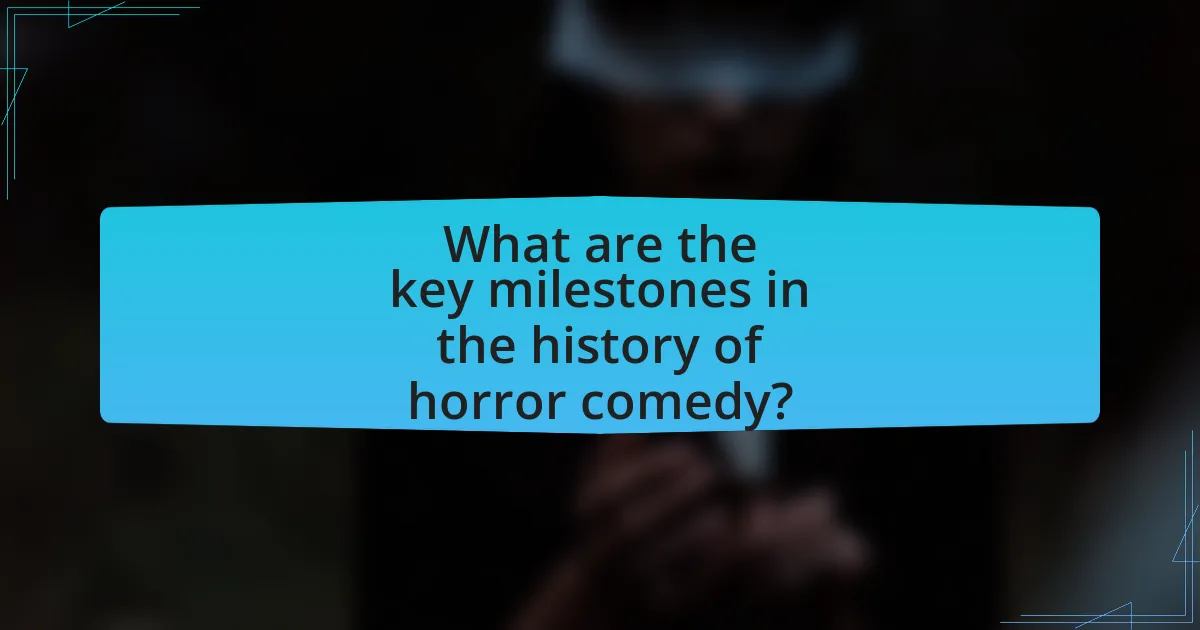
What are the key milestones in the history of horror comedy?
The key milestones in the history of horror comedy include the release of “Abbott and Costello Meet Frankenstein” in 1948, which blended humor with classic horror monsters, and the emergence of “Shaun of the Dead” in 2004, which revitalized the genre by combining zombie horror with comedic elements. Additionally, the 1980s saw the rise of films like “The Evil Dead II,” which established a cult following by mixing slapstick humor with horror. These films demonstrate the evolution of horror comedy, showcasing how the genre has successfully merged fear and laughter over the decades.
Which films marked the beginning of horror comedy as a genre?
The films that marked the beginning of horror comedy as a genre include “Abbott and Costello Meet Frankenstein” (1948) and “The Ghost Breakers” (1940). “Abbott and Costello Meet Frankenstein” is often credited for blending humor with horror elements, featuring iconic monsters like Dracula and Frankenstein’s monster in a comedic context. “The Ghost Breakers” also combined comedic performances with supernatural themes, setting a precedent for future horror comedies. These films established a framework that influenced the genre’s development, showcasing how humor could coexist with horror.
What innovations did early horror comedies introduce?
Early horror comedies introduced the innovation of blending humor with traditional horror elements, creating a unique genre that appealed to a broader audience. This fusion allowed filmmakers to explore themes of fear and absurdity simultaneously, exemplified by films like “Abbott and Costello Meet Frankenstein” which combined slapstick comedy with classic horror characters. Additionally, early horror comedies utilized parody and satire to critique societal norms and the horror genre itself, paving the way for future comedic interpretations of horror tropes. This innovative approach not only expanded the narrative possibilities within horror but also established a template for subsequent films that sought to balance scares with laughs.
How did the 1980s influence the evolution of horror comedy?
The 1980s significantly influenced the evolution of horror comedy by blending traditional horror elements with humor, leading to a new genre that appealed to a broader audience. This decade saw the release of iconic films such as “Ghostbusters” (1984) and “The Evil Dead II” (1987), which combined scares with comedic moments, establishing a template for future productions. The success of these films demonstrated that horror could be commercially viable when infused with humor, encouraging filmmakers to experiment with the genre. Additionally, the rise of slasher films in the early 1980s, like “A Nightmare on Elm Street” (1984), often included self-referential humor, further solidifying the horror comedy hybrid. This era laid the groundwork for the genre’s continued evolution in subsequent decades, influencing filmmakers to explore the interplay between fear and laughter.
What are some iconic horror comedy films from each decade?
Iconic horror comedy films from each decade include “Abbott and Costello Meet Frankenstein” (1948) in the 1940s, “Ghostbusters” (1984) in the 1980s, and “Shaun of the Dead” (2004) in the 2000s. Each of these films has significantly influenced the genre, blending humor with horror elements. “Abbott and Costello Meet Frankenstein” is notable for its comedic take on classic Universal monsters, while “Ghostbusters” became a cultural phenomenon with its mix of supernatural themes and humor. “Shaun of the Dead” revitalized the zombie genre with its clever writing and comedic approach, showcasing the evolution of horror comedy over the decades.
How did the 1990s redefine horror comedy tropes?
The 1990s redefined horror comedy tropes by blending self-referential humor with traditional horror elements, creating a meta-narrative that appealed to both genre fans and mainstream audiences. Films like “Scream” (1996) and “The Cabin in the Woods” (2011) showcased characters who were aware of horror clichés, allowing for a satirical take on the genre while still delivering genuine scares. This era also emphasized a more playful approach to horror, as seen in “Shaun of the Dead” (2004), which combined zombie apocalypse scenarios with comedic elements, thus establishing a template for future horror comedies. The success of these films demonstrated that audiences appreciated a mix of humor and horror, leading to a lasting impact on how the genre was perceived and produced.
What contemporary films are shaping the future of horror comedy?
Contemporary films shaping the future of horror comedy include “The Cabin in the Woods,” “What We Do in the Shadows,” and “Ready or Not.” “The Cabin in the Woods” (2011) redefined the genre by blending traditional horror tropes with self-awareness and satire, influencing subsequent films to explore meta-narratives. “What We Do in the Shadows” (2014) introduced a mockumentary style that has inspired a wave of comedic horror films focusing on character-driven humor. “Ready or Not” (2019) combined dark humor with social commentary, showcasing how horror comedy can address contemporary themes while maintaining suspense and entertainment. These films collectively demonstrate a trend towards innovative storytelling and genre-blending that is likely to influence future productions in horror comedy.
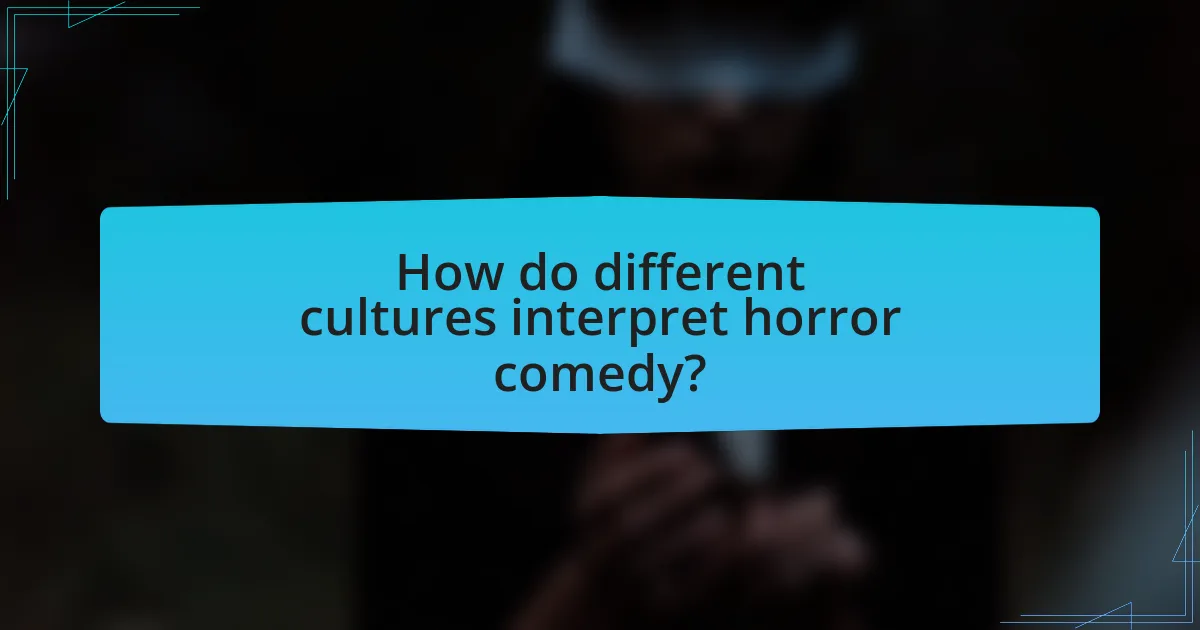
How do different cultures interpret horror comedy?
Different cultures interpret horror comedy through their unique societal norms, beliefs, and historical contexts. For instance, in American culture, horror comedy often blends slapstick humor with elements of traditional horror, as seen in films like “Shaun of the Dead,” which juxtaposes zombie apocalypse scenarios with comedic situations. In contrast, Japanese horror comedy, exemplified by films like “Ringu,” often incorporates supernatural elements and cultural folklore, leading to a more subtle and psychological form of humor that reflects societal fears. Additionally, Latin American interpretations, such as in “Coco,” utilize vibrant storytelling and music to address themes of death and the afterlife, merging humor with cultural reverence for ancestors. These variations highlight how cultural backgrounds shape the themes, humor styles, and narrative structures within horror comedy, demonstrating the genre’s adaptability and resonance across different societies.
What are some notable international horror comedies?
Notable international horror comedies include “Shaun of the Dead” from the United Kingdom, “What We Do in the Shadows” from New Zealand, and “Tucker and Dale vs. Evil” from Canada. “Shaun of the Dead,” directed by Edgar Wright, is a seminal film that blends zombie horror with British humor, achieving critical acclaim and commercial success. “What We Do in the Shadows,” directed by Jemaine Clement and Taika Waititi, offers a mockumentary style that humorously explores the lives of vampire roommates, gaining a cult following. “Tucker and Dale vs. Evil,” directed by Eli Craig, subverts typical horror tropes by portraying two well-meaning hillbillies as misunderstood characters, which has resonated with audiences and critics alike. These films exemplify the genre’s ability to blend humor with horror across different cultures.
How do cultural differences affect humor in horror films?
Cultural differences significantly affect humor in horror films by shaping the types of jokes and comedic elements that resonate with audiences. For instance, in Western horror comedies, humor often derives from self-referential satire and absurdity, as seen in films like “Shaun of the Dead,” which blends zombie horror with British wit. Conversely, Asian horror comedies, such as “Scary Movie” in the Philippines, may incorporate local folklore and societal norms, leading to humor that is more situational and culturally specific. This variation is supported by research indicating that humor is heavily influenced by cultural context, with studies showing that what is considered funny in one culture may be perceived as offensive or confusing in another. Thus, the interplay of cultural backgrounds and comedic styles creates diverse experiences in horror films across different regions.
What themes are prevalent in non-Western horror comedies?
Prevalent themes in non-Western horror comedies include cultural identity, social commentary, and the blending of traditional folklore with modern humor. Cultural identity often manifests through the exploration of local customs and beliefs, allowing audiences to connect with their heritage while engaging in comedic narratives. Social commentary is frequently employed to critique societal norms, politics, or class structures, using humor as a vehicle for deeper reflection. Additionally, the integration of traditional folklore into contemporary settings creates a unique juxtaposition that enhances both the horror and comedic elements, as seen in films from countries like Japan and Thailand, where local myths are humorously reinterpreted.
How does horror comedy intersect with other genres?
Horror comedy intersects with other genres by blending elements of horror and humor to create a unique narrative experience. This intersection often incorporates aspects of action, fantasy, and even romance, allowing for diverse storytelling techniques. For instance, films like “Shaun of the Dead” combine zombie horror with comedic elements, showcasing how tension and humor can coexist. Additionally, horror comedies like “What We Do in the Shadows” merge mockumentary styles with supernatural themes, illustrating the versatility of the genre. This fusion not only appeals to a broader audience but also allows for innovative plot developments and character dynamics, reinforcing the genre’s evolution over time.
What are the common elements between horror comedy and slasher films?
Horror comedy and slasher films share common elements such as the use of humor to juxtapose fear and tension, and the presence of exaggerated violence. Both genres often feature a cast of characters that includes archetypes like the final girl, who survives to confront the antagonist, and comic relief characters that provide levity amidst horror. Additionally, they utilize suspenseful pacing and shocking plot twists to engage the audience, creating a blend of laughter and fright. The interplay of these elements can be seen in films like “Scream,” which parodies slasher tropes while maintaining the genre’s core characteristics.
How does horror comedy blend with romantic comedy?
Horror comedy blends with romantic comedy by juxtaposing elements of fear and humor with themes of love and relationships. This combination allows for comedic relief in tense situations, often using absurdity and irony to highlight romantic pursuits amidst horror scenarios. For instance, films like “Shaun of the Dead” effectively merge these genres by incorporating romantic subplots while maintaining horror tropes, demonstrating that characters can navigate both love and danger simultaneously. This blending creates a unique narrative dynamic that appeals to audiences seeking both thrills and laughs, showcasing the versatility of storytelling in cinema.
What can we learn from the evolution of horror comedy?
The evolution of horror comedy teaches us about the blending of genres and societal reflections in entertainment. This genre has transformed from early silent films like “The Cabinet of Dr. Caligari” to contemporary works such as “What We Do in the Shadows,” showcasing how humor can be used to address fears and anxieties. The success of films like “Shaun of the Dead” illustrates that horror comedy can effectively critique social issues while providing entertainment, demonstrating the genre’s adaptability and relevance over time.
How can filmmakers effectively combine horror and comedy today?
Filmmakers can effectively combine horror and comedy today by utilizing a balance of tension and humor, often through character-driven narratives and situational irony. This approach allows for the juxtaposition of frightening scenarios with comedic elements, creating a unique viewing experience that engages audiences on multiple levels. For instance, films like “What We Do in the Shadows” and “The Cabin in the Woods” demonstrate this technique by blending horror tropes with comedic dialogue and absurd situations, which not only entertain but also critique the genre itself. The success of these films indicates that a well-crafted script that intertwines humor with horror can resonate with viewers, making the combination both effective and appealing.
What are the best practices for writing a horror comedy script?
The best practices for writing a horror comedy script include balancing humor and horror elements, developing relatable characters, and maintaining a consistent tone. Balancing humor and horror ensures that comedic moments do not undermine the suspense or fear, while relatable characters help the audience connect emotionally, enhancing both the comedic and horror aspects. Maintaining a consistent tone throughout the script is crucial, as it allows for seamless transitions between comedic and scary moments, keeping the audience engaged. Successful horror comedies, such as “Shaun of the Dead,” exemplify these practices by effectively blending humor with genuine horror, demonstrating that a well-crafted script can resonate with audiences across both genres.

